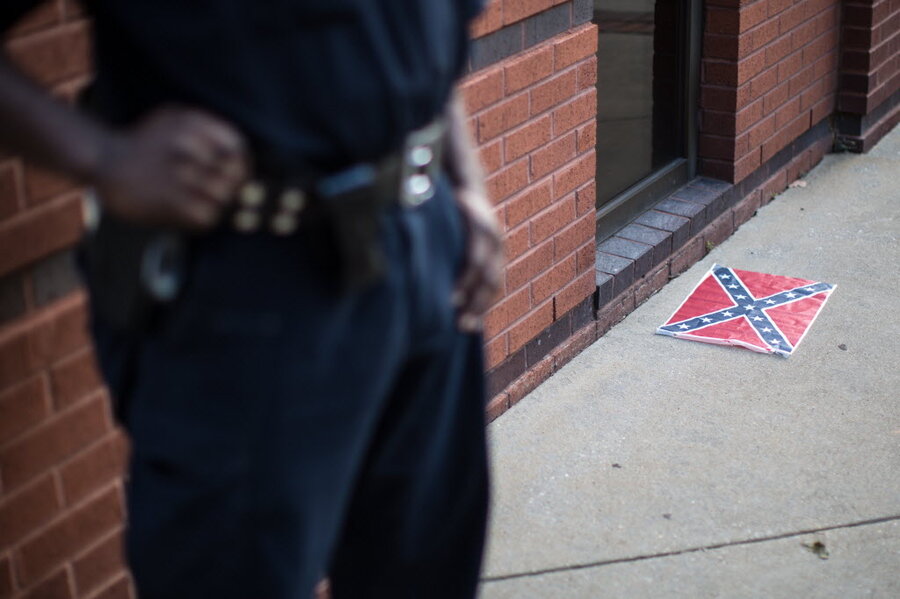With Confederate flags at MLK church, fight for national identity persists
Loading...
The placing of four Confederate flags next to a US civil rights landmark in Atlanta was perhaps part “terroristic tactic,” as one religious leader remarked. But it also represented a stick-in-the-eye strategy fomented by some Southerners, suggesting that a fight for the future of the country, and its symbolic identity, is not over.
Officials from the Atlanta Police Department, the Federal Bureau of Investigation, and the Department of Homeland Security are debating whether any laws were actually broken by the placement of the flags. A surveillance camera indicates that two white men laid the flags on the lawn near the historic Ebenezer Baptist Church at about 1:30 Thursday morning.
But for many, the symbolism was profound just over a month after a Confederate flag-waving white supremacist killed nine black parishioners during a Bible study at another historic church, in Charleston, S.C. The incident comes amid a building backlash among some Southerners against efforts to remove Confederate symbols from public places, and it underscores a difficult moment for a nation that has yet to entirely escape the bounds of the Civil War and fully reshape its identity to reflect deeper diversity.
“What you have here is a battle for history and how we remember history, but also a battle for where the country is going or seems to be going,” says Harcourt Fuller, a history professor at Georgia State University in Atlanta. “It’s a continuation of the Civil War, which has not really ended culturally. The battle flag represents that fact more than any other symbol.”
The flags were placed on the grass just a day before Dylann Roof faced a slew of federal hate crime charges at a court hearing, in connection with the Charleston shooting. Mr. Roof pleaded not guilty to the federal charges, which are on top of a long list of state murder charges.
The Charleston shooting focused the nation on the salience of the Confederate flag when photographs emerged showing Roof burning an American flag and displaying the Confederate “Navy Jack,” or battle flag. The latter banner is a complicated symbol that represents both Southern valor in battle and the political oppression of blacks in the South in the run-up to the civil rights movement.
“It’s fascinating that we’ve gone from nobody talking about the Confederate flag to all of a sudden, it’s become the issue,” says Heather Cox Richardson, a history professor at Boston College, in an interview with the Monitor. “This will be in the history books in 100 years, because it crystallizes 50 years of antigovernment rhetoric by movement conservatives.”
In the weeks since the South Carolina legislature, after a 13-hour debate, voted to remove the battle flag from the State House grounds, descendants of Civil War soldiers have gone on a symbolic offensive.
To be sure, the cohort of Confederate stalwarts is probably small, suggests James Loewen, co-editor of “The Confederate and Neo-Confederate Reader.” “Two white men leaving Confederate flags on the ground at night shows how puny the neo-Confederate force has become,” Mr. Loewen writes in an e-mail to the Monitor.
Yet shows of support for the Confederate battle flag are hardly rare. Outside Atlanta’s city limits, in towns like Covington and Alto, Ga., it’s common to see at least one truck, and often many, trailing battle flags.
And there’s evidence of a larger movement afoot. The Virginia Flaggers, a heritage group devoted to erecting large Confederate battle flags near public highways, has stepped up its efforts.
“Across the South, her citizens see these continued attacks [on Confederate symbols] as an organized attempt to eradicate our history and heritage, and we are ready to stand and defend the honor of our Veterans who paid the ultimate sacrifice for their country,” writes Grayson Jennings on the Virginia Flaggers’ blog.
The Virginia Flaggers, much like the Sons of Confederate Veterans, condemns the use of the battle flag by white supremacist groups like the Ku Klux Klan and Aryan Nations. Yet historians say it has become nearly impossible to unfurl the flag’s historic meaning from other connotations, especially amid deep racial and cultural tensions.
In comparison with waving flags on private property, the surreptitious placing of the flags at a historic civil rights site is more vexing. For one thing, it forces federal law enforcement officials to explore the line between constitutional free speech and physical threat.
The backdrop of the incident is equally complex, given Jim Crow-era terror campaigns by white supremacists against blacks, often focusing on black churches. Martin Luther King Jr. preached at Ebenezer Baptist Church.
"Whatever the message was, it was clearly not about heritage. It was about hate," the Rev. Dr. Raphael Warnock, Ebenezer’s senior pastor, said in comments to the press Thursday. "This act by a cowardly and misguided individual or individuals is provocative to say the least."
Based on current laws, there may not be much for law enforcement to do, even if they can identify the two men in the surveillance video. But some legal experts say the act may violate laws against church vandalism, although nothing was damaged or permanently scarred.
Among those who support the flag, their reasons are complex, often mixing “elements of race, elements of geopolitics, and elements of culture,” says Professor Fuller at Georgia State University. “It says, ‘We are not going away. You may have won this battle, but we’re still here.’ ”
Thus the fight for the future of the country and its symbolic identity.
“This is not just about a flag,” Professor Richardson told the Pittsburgh Post-Gazette recently. “This is not just about race. This is about America, who is going to control America.”








